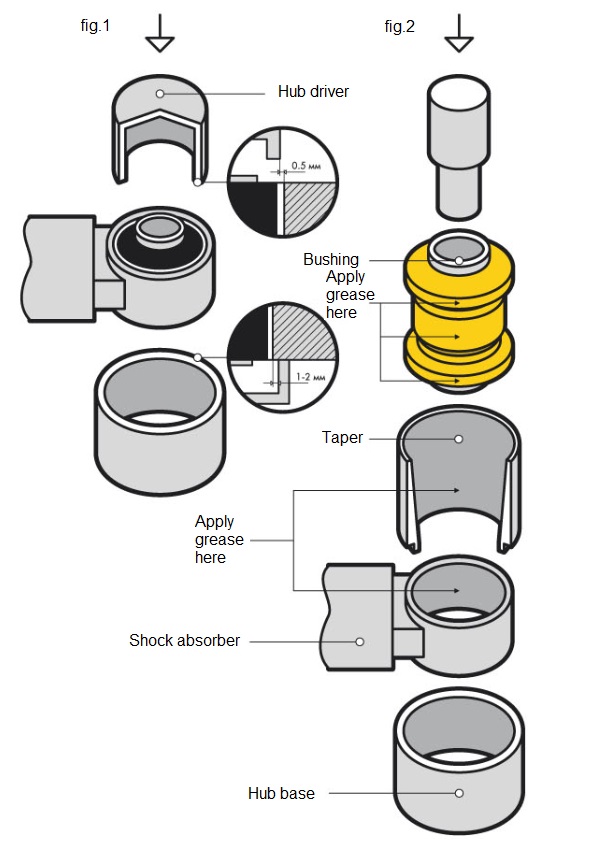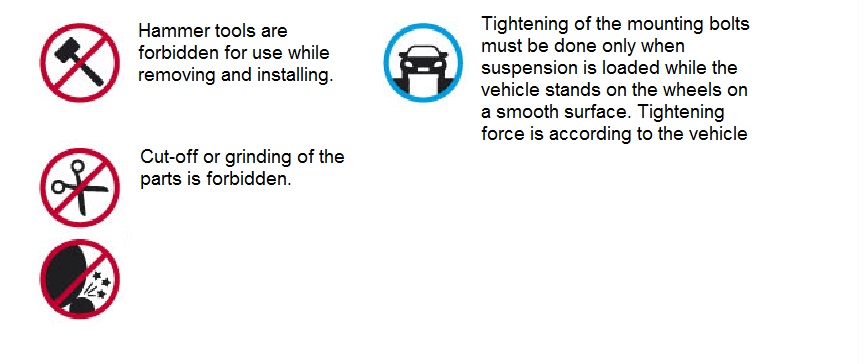Removal
Attention! Original stabilizer bushing has the outer metal shell. Choose the metal tubings (hub base and hub driver) for the removal and installation. O.D. of the hub driver must be 0,5 mm. less than O.D. of the outer metal shell to avoid damage of the housing bore. I.D. of the hub base must be 1-2 mm. bigger than O.D. of the outer metal shell not to interfere the removing of bushing.
- Place a stabilizer upon the hub base into the press (fig.1).
- Place a hub driver upon the bushing.
- Press an old bushing out of the arm increasing pressure gradually to avoid a skewness and deformation of the hub driver and housing bore.
- After pressing old bushing out, inspect the surface of the stabilizer housing bore, clean, file and polish if any dirt, rust, burr.
Installation
Attention! Stabilizer bushing 1-06-135 unlike the original one does not have the outer metal shell. It is recommended to install such bushings using a taper. Pressing force should be applied to the inner metal sleeve.
- Choose a taper with I.D equal to the housing bore, choose the hub driver for pressing in with O.D. equal to the diameter of the inner sleeve. Choose a hub base with I.D. 1-2 mm. bigger than O.D. of the bushing’s flange.
- Lubricate a taper inside, housing bore in the stabilizer, outer surface of the bushing with supplied grease or any other consistent grease.
- Place a stabilizer upon the hub base into the press (fig.2).
- Place a taper upon the housing bore.
- Place a bushing into the taper.
- Place a hub driver upon the inner metal sleeve of the bushing.
- Start pressing. Increase the load gradually to make bushing spreading evenly until it fills the housing bore completely.
- Initially bushing may slip into the housing bore slightly skewed because of the difference in diameters of hub driver, housing bore and bushing. Due to the resiliency of the bushing, it’s bigger diameter allows to fill the housing bore completely and fix the bushing properly.
- After new bushing is pressed in, remove excess grease. Check the symmetry of the bushing’s placement and tightness of the flanges to the housing bore. If necessary, align the bushing in the housing bore.

| Possible
problems*
*Are not a result of the parts defects and can’t be considered as a warranty case |
Inner metal sleeve torn off. | Control arm bushing without outer metal shell doesn`t slip into the housing bore because of bulging elastomer. | Bushing is not holding in the housing bore. |
| Wearout of the stabilizer and / or arm’s housing bores. |
|
X
|
|
| Another parts of suspension are worn out. As a result, the load on bushings is uneven. |
X
|
|
|
| Vehicle was operated in excess of the maximum capacity. |
X
|
|
|
| Grease is washed out over time or the grease was not attached during the installation. |
X
|
|
|
| Inner sleeve or outer shell is not adhered to the elastomer by design specificity. |
X
|
|
|
| Vehicle is raised on and suspension geometry is broken. |
X
|
|
|
| Bushing was installed without taper that is necessary for the installation of the bushings without outer metal shell. |
X
|
||
| Bushing has been trimmed or ground. |
X
|
||
| Wrong choice of the bushing (incorrect OEM). |
X
|
X
|
|
| Sharpened edges of the housing bore were not filed and caused a damage of the bushing during the installation. |
X
|

